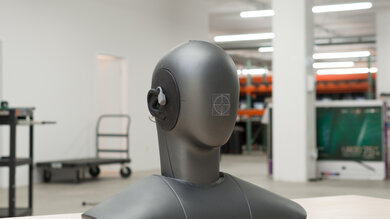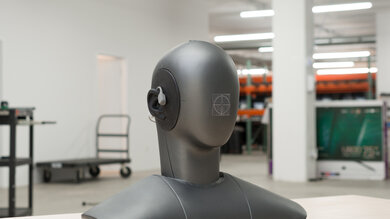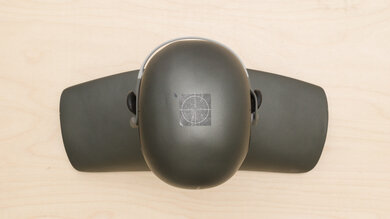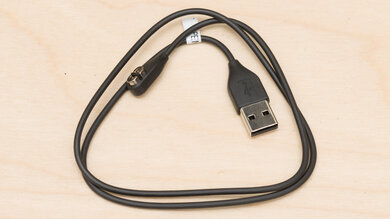The Shokz OpenRun Bone Conduction are the next generation of the AfterShokz Aeropex Bone Conduction. Unlike most traditional sports-oriented headphones, they produce sound by sending vibrations from your cheekbones to your inner ear instead of directly playing audio from speakers. As a result, they don't enter your ear at all, allowing you to stay aware of your surroundings, which is handy if you're running outdoors. Their IP67 rating also means they're fully dust, sweat, and waterproof, making them suitable for even the most intense workouts.

Looking for Black Friday savings on your next pair of headphones? We've got you covered! Check out our Early Black Friday 2025 Deals article for what's worthwhile this year.
Our Verdict
The Shokz OpenRun are disappointing for neutral sound. Our testing rig can't adequately measure their performance because they use vibrations to reproduce audio. In real-life use, they struggle to reproduce a thumpy low-bass, which results in a somewhat flat sound. They have very smooth and accurate mids, so vocals and lead instruments sound clear, present, and detailed. Sibilants like cymbals are also bright but not piercing. However, their bass and treble delivery vary, so it's important to take the time to adjust their fit and positioning to ensure a more consistent sound. Wearing earplugs will greatly increase their sound quality but won't let you hear around you as well. That said, these headphones weren't designed with neutral sound in mind and will be adequate for soundtracking daily activities.
- Comfortable, stable fit.
- Really lack bass.
- Audio delivery depends on the headphones' fit and positioning.
The Shokz OpenRun are sub-par for commute and travel. By design, they don't enter or cover your ears, so you hear all the noise from bus engines and commuter chit-chat. They also leak audio at high volumes. However, if you don't mind this, they have a comfortable fit and are well-built. They also have 13 hours of continuous battery life, which will last through long days on the go. Their low latency on iOS and Android devices makes them a suitable choice if you like streaming videos during your trip.
- Comfortable, stable fit.
- 13-hour continuous battery life.
- Leak a lot of audio at high volumes.
- Audio delivery depends on the headphones' fit and positioning.
The Shokz OpenRun are decent for sports and fitness. Since they don't cover your ears, you can listen to your favorite audio while still hearing sounds around you, which is ideal if you're running outdoors. They have a comfortable and stable fit, are well-built, and are rated IP67 for dust and water resistance. Their neckband won't fit into your pockets, but you can wear them on your head or around your neck when you're not using them.
- Comfortable, stable fit.
- Well-built and rated IP67 for dust and water resistance.
- 13-hour continuous battery life.
- Audio delivery depends on the headphones' fit and positioning.
The Shokz OpenRun can be a suitable choice at the office if you want to listen to audio while still monitoring what's going on around you. Due to their bone conduction design, their transducers sit on your cheekbones rather than in your ears. As a result, they won't block out any sounds around you. They also leak a lot of audio at high volumes. They have a comfortable design, roughly 13 hours of continuous playback time, and are well-built. They also support multi-device pairing, meaning you can simultaneously stay connected to your laptop and smartphone.
- Supports multi-device pairing.
- Comfortable, stable fit.
- 13-hour continuous battery life.
- Leak a lot of audio at high volumes.
The Shokz OpenRun are Bluetooth-only headphones. They're compatible with Bluetooth-enabled PCs, but their latency is too high for gaming.
The Shokz OpenRun are Bluetooth-only headphones; you can't use them wired.
The Shokz OpenRun are sub-par for phone calls. They have an integrated mic that does a decent job recording your voice, ensuring it sounds clear and natural. However, the mic has some trouble separating your voice from moderate ambient noise, so if you're taking a call from a busy street, your voice can be drowned out. Since these headphones don't go into or sit around the ear, they also don't block out ambient sound. If you're taking a call from a noisy office, you can have a hard time hearing your call well.
- Comfortable, stable fit.
- Decent recording quality.
Changelog
-
Updated Nov 27, 2025:
We've updated the review to mention the Suunto Wing in the Battery box.
-
Updated Aug 26, 2025:
We've added a link to our article about bone conduction headphones in Popular Headphones Comparisons.
-
Updated Mar 26, 2025:
The Stability section compares the fit to the Shokz OpenRun Pro 2 Bone Conduction.
- Updated Jul 04, 2024: We've updated this review to add the Costco-exclusive Shokz OpenRun SE as a variant, which come in 'Dark Gray.'
Check Price
Differences Between Sizes And Variants
The Shokz OpenRun come in four color variants: 'Black,' 'Blue,' 'Grey,' and 'Red.' There's also a variant sold through Costco, marketed as the Shokz OpenRun SE. It's available in 'Dark Gray' but seems to have identical specifications to other variants. We tested the 'Grey' variant; you can see our model's label here. Older models of these headphones might come bearing the "AfterShokz" name and logo, but the company has since changed its name to Shokz.
These headphones also come in a mini size, with a neckband about one inch smaller than the original standard model. However, the mini variant is only available in 'Black.' We expect the mini version to perform similarly to the regular-size variant we tested. If you encounter another variant, please let us know in the discussions, and we'll update our review.
Popular Headphones Comparisons
The Shokz OpenRun are bone conduction headphones replacing the AfterShokz Aeropex Bone Conduction. Unlike traditional sports earbuds like the Jaybird Vista 2 Truly Wireless, their design doesn't block out any background noise, allowing you to hear ambient sounds around you, whether you're running outdoors or working in a collaborative office. In this sense, they're similar to open-back sports headphones like the Bose Sport Open Earbuds and Shokz OpenFit True Wireless, which differ in that they reproduce sound through speakers that sit outside of your ear canal.
Check out our recommendations for the best headphones for running and the best wireless Bluetooth earbuds. If you're curious about how bone conduction headphones work, we have an article on the topic, too.
Depending on your needs, you may prefer the Shokz OpenRun Pro 2 Bone Conduction or the Shokz OpenRun Bone Conduction. The OpenRun Pro 2 has improvements like fewer vibrations from the bone conduction drivers and a USB-C charging port instead of the proprietary battery charger with the OpenRun. The OpenRun Pro 2's app lets you change the EQ, and its mic performance is improved. Folks can get it in a smaller size if needed, which makes a difference in sound and comfort. However, the standard OpenRun has a higher IP67 rating, which might override other considerations for the truly outdoorsy.
The Shokz OpenRun Pro Bone Conduction are the upgraded variant of the Shokz OpenRun Bone Conduction. While both headphones are comfortable, the Pro come with a better hard case to protect the headphones when you're not using them. They also reproduce a bit more bass, though it's likely not enough if you like thumpy genres like EDM and hip-hop. That said, their companion app offers a couple of EQ presets to help you adjust their sound. The original OpenRun have a higher IP67 rating for dust and water resistance.
The Shokz OpenRun Bone Conduction are the next generation of the AfterShokz Aeropex Bone Conduction. While both are otherwise the same in terms of build quality, comfort, and sound quality, the OpenRun have a quick charge feature, and they support Bluetooth 5.1. The Aeropex come with two charging cables instead of one, and their soft case is better than the OpenRun's drawstring pouch.
The Shokz OpenRun Bone Conduction and the Shokz OpenFit True Wireless are sporty headphones with differing forms of sound reproduction. The OpenRun use vibrations on your bones to produce sound and have a headband, making them a bit bulkier than their truly wireless counterpart. Their IP rating is different, too, and they can survive water immersion, which can be handy if you want to run in the rain. They also have a longer continuous playback time, and you can pair them with up to two devices simultaneously. On the flip side, the OpenFit sit just outside your ear canal and use speakers to play your audio. They have a more stable fit, deliver more bass, and are customizable, thanks to their companion app support.
Test Results
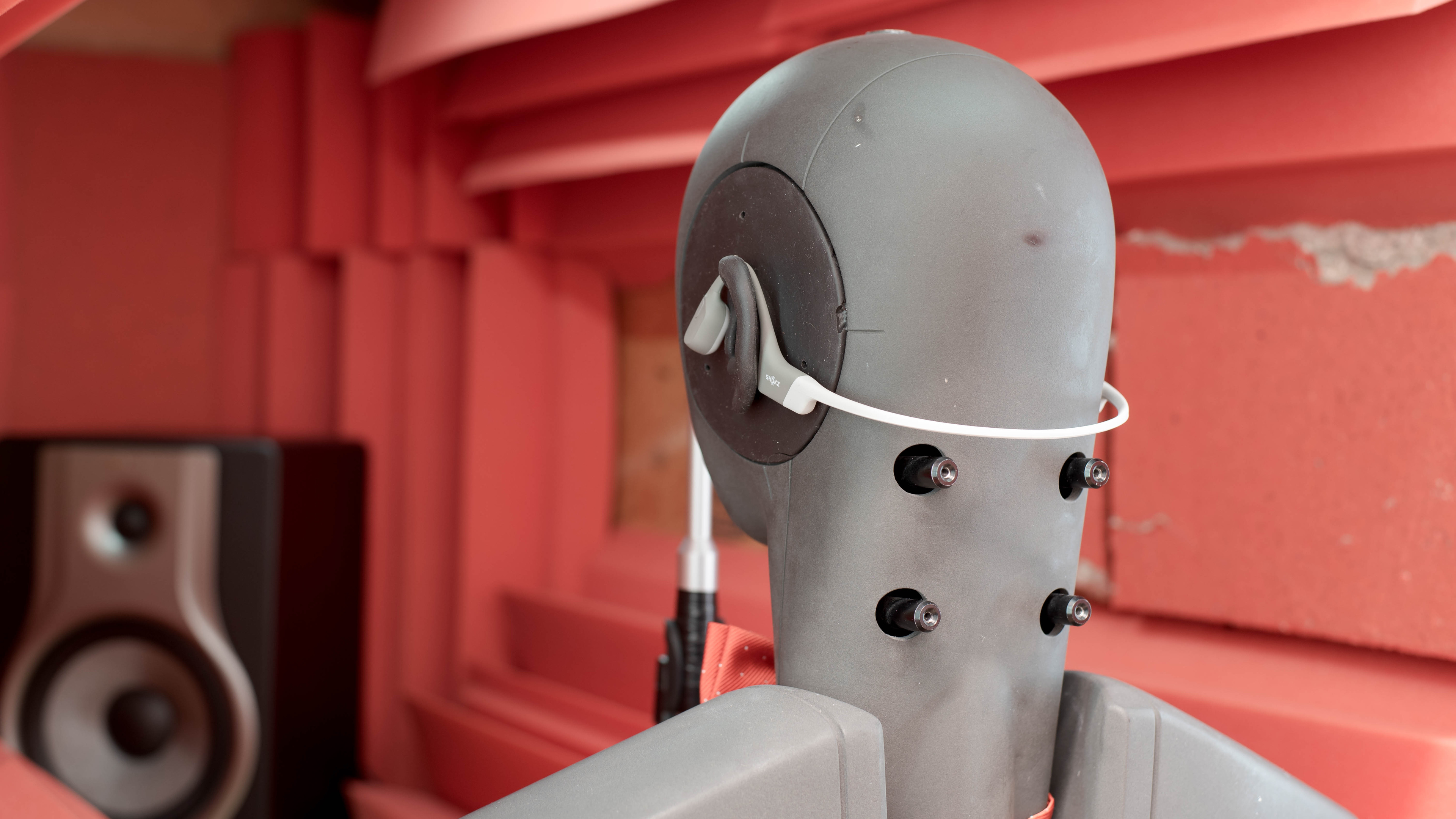
The Shokz OpenRun look nearly identical to the AfterShokz Aeropex Bone Conduction. They have a band that goes around the back of your head, and the ear hooks help the headphones rest on your cheekbones. They come in four different colors: 'Black,' 'Grey,' 'Red,' 'Blue,' and the Costco-exclusive Dark Gray.' They also come in a mini version, which has a shorter band. However, this variant only comes in 'Black'.
The Shokz OpenRun are comfortable headphones. Like the Shokz OpenRun Pro Bone Conduction, they don't weigh very much, and since they're bone-conduction headphones, they don't enter your ear. However, they put a small amount of pressure on the top of your ears, which feels similar to wearing glasses. If you're wearing glasses and these headphones at the same time, it can be uncomfortable.
The Shokz OpenRun have controls that are decently easy to use. The three buttons are easy to use and are very clicky. On the left side is a multi-function that controls most audio-related playback. The right side has a power plus volume up ('+') button and a volume down button ('-'). There are lots of voice prompts to let you know when you've registered a command. That said, remembering the commands for some controls can be a little tricky.
Plus '+' button:
- Single press: Volume up.
- Press when not connected to device: Hear battery life.
Minus '-' button:
- Single press: Volume down.
Multi-function button:
- Single press: Plays and pauses audio. Also answers calls.
- Double press: Skips to the next track when you're listening to audio. If you're pairing the headphones, this switches the language of the voice prompts.
- Triple press: Skips to the previous track when you're listening to audio.
- Press and hold: Activates voice assistant when the headphones are on standby mode.
Button Combinations:
- Multi-function and Plus (+) Buttons: While in pairing mode, press and hold both buttons to enable multi-point connection.
- Plus (+) and Minus (-) Buttons: While listening to music, press and hold both buttons to switch to EQ mode.
The Shokz OpenRun are decently portable. Like the AfterShokz Aeropex Bone Conduction, their rigid headband can't fold into a more compact form, making it difficult to store them in your pants or jacket pocket. On the upside, they come with a small soft pouch to help protect them when you're on the go. They're also very light and portable when they're on your ears or around your neck if you're not using them.
The Shokz OpenRun have a good build quality. They're mostly silicone, making them feel sturdy and solid. Thanks to their IP67 rating for dust and water resistance, they're a solid choice for hard workouts or runs in the park, as they're dust-tight and can handle immersion in water. However, the neckband is a bit thin and feels like a weak point.
The Shokz OpenRun have good stability. Since the headphones hook over your ears, they don't move around much, even during more intense physical movement. There's space between your head and the neckband, meaning the band can get caught on clothing like a hood. Since these are a one-size-fits-most design, the stability depends on how much or how little it clamps to the sides of your head. If you have a smaller-than-average head, the headset will shift around more, and you might prefer the fit of Shokz OpenRun Pro 2 Bone Conduction, which you can get in Mini or Standard size.
The Shokz OpenRun use vibration to produce sound, and our testing rig can't accurately measure these results. The frequency response graph doesn't portray sound as a human ear hears it. They have a bright sound profile that struggles to reproduce any bass frequencies. Vocals and lead instruments sound clear, present, and detailed. However, they can't reproduce thumpy low-bass, so genres like EDM and hip-hop sound flat. If you prefer a different sound, they have two EQ presets built-in: 'Standard', which is their default preset, and 'Vocal Booster', which improves vocal clarity.
We've received user interest in testing the headphones while the ear canal is obstructed. You may wear earplugs to block background noise or use a hearing aid but still want good sound delivery. Due to issues with our test rig and these headphones, we couldn't get accurate measurements for the new test. Our results indicate a drop off in treble range delivery, but when subjectively listening, the high-end frequencies are rather more present and detailed. You also definitely feel the bass frequencies to be louder and get more thump out of them.
Note: Headphones are normally tested at 90dB and 100dB. However, the Shokz OpenRun can't reach these volumes on the testing dummy head. Even when we use the headphones on our own heads and measure their volume using in-ear microphones, they can't reach 90dB. Their max sound is 85dB, so we conducted testing at 75dB and 85dB. Their max volume is still very loud, and using them at this volume is still fairly uncomfortable as they vibrate a lot, which can numb your cheekbones during long listening sessions.
These headphones have sub-par frequency response consistency. They're prone to bass and treble delivery inconsistencies due to their bone conduction design. As they're very sensitive to fit and positioning, it's important to take the time to achieve a good fit.
The Shokz OpenRun lack a lot of bass. Since they produce sound using vibrations, they struggle to reproduce a rumbly low-bass. Electronic songs with a thumpy beat, like Territory by The Blaze, sound thin and lacking in body. That said, there's some high-bass present so that mixes don't totally lack fullness. It won't be enough for more bass-heavy genres like EDM and hip-hop, but it suffices for content like classical or podcasts that don't rely so heavily on this range. If you want to get more bass out of these headphones, wearing earplugs will help your inner ear focus strictly on the audio generated by the OpenRun. It's an extra step, but it can greatly increase the amount of bass delivered, as you can see here.
These headphones have great mid accuracy. Voices sound clear, detailed, and present, which is nice if you like to listen to podcasts or audiobooks. That said, more musical genres sound great, too. If you're listening to the second verse of the song Sanctuary by Joji, his voice sounds lush and fairly transparent.
The Shokz OpenRun have excellent treble accuracy. The upper harmonics of vocals and lead instruments are clear, present, and detailed. Sibilants like S and T sounds are a little bright but not too sharp. If you wear these headphones with earplugs in, the treble range may sound louder and more present.
The Shokz OpenRun produce sound via vibrations on your bones, and our testing rig can't properly measure their frequency response. That said, as these headphones struggle to reproduce bass, it doesn't seem like there are many peaks and dips in this range. The exception is a large peak in the high-bass and low-mids that gives bass instruments, like kick drums and bass guitars, some more emphasized presence. There's also a peak in the mid-treble range, making sibilants like cymbals piercing.
The Shokz OpenRun are bone-conducting headphones, and our testing rig isn't designed to test them. Therefore, the graphs and score for imaging aren't as accurate compared to other headphones we've tested. Although our results indicate a significant deviation in the group delay in the bass range, it's not audible as these headphones can't produce these frequencies. Since they use vibrations to reproduce sound, the fit has a major impact on how you perceive their imaging performance. Overall, the L/R drivers seem well-matched in frequency, although the left driver outputs a slightly higher volume than the right. It's not very noticeable with real-life content, though. That said, imaging can vary between units and can indicate a manufacturer's quality control and ergonomics.
Our testing rig can't accurately measure the Shokz OpenRun's passive soundstage. By design, their transducers sit outside and away from your ear. They also produce sound via vibrations that travel along your cheekbones to your inner ear. Their soundstage seems open as a result, but sound seems to be coming from inside your head rather than from speakers in the room around you.
These headphones have a poor weighted harmonic distortion performance. At high volumes, they vibrate a lot, which is very uncomfortable and can numb your cheekbones. However, they aren't meant for use at very high volumes as they add background audio to your normal sound environment. It's unlikely that you'll use these headphones at a very high volume, but if you do, you may experience facial discomfort and distorted audio reproduction.
These are the settings used to test the Shokz OpenRun. Our results are only valid when used in this configuration.
The Shokz OpenRun have a bad noise isolation performance. They don't block out any background noise as they don't cover or enter your ear. This design can be helpful if you want to stay aware of your surroundings while you're exercising outside. That said, they don't cut down any of the low rumble of bus engines, ambient chatter, or the high-pitched hum of AC units. Commuters who want to be isolated from these external noises will prefer the performance of in-ear headphones or those with ANC. That said, the Shokz are still a good choice for commuting if you want to be aware of what's happening around you while traveling.
The Shokz OpenRun have a mediocre leakage performance. They leak a lot of audio at high volumes, which can disturb others around you, even if you're listening to audio in a moderately noisy environment.
When connected to a PC, these headphones' integrated mic has a decent recording quality. Your voice sounds clear and natural, although lacking in body. The mic's recording quality when you're connected via your phone is also quite similar in performance.
The integrated mic has a mediocre noise handling performance. When connected to a PC, moderate background noise coming from a busy street can drown out your voice. If you're using your phone, they do a similarly okay job of separating your voice from pink noise. While the mic does a marginally better job of separating your voice from subway noise when using your phone, it's still difficult to hear your voice clearly if surrounded by loud noise.
The Shokz OpenRun have a decent battery performance. The manufacturer advertises them as having eight hours of playtime, and we measured roughly 13 hours. This aligns with other Shokz (Aftershokz) headphones that we've tested. Unlike the AfterShokz Aeropex Bone Conduction, they feature a quick charge capability, which can help replenish their battery when you're short on time. They also have a standby mode that helps conserve battery life when not in use. That said, they use a proprietary charging cable, so if you lose or misplace it, you'll need to purchase a new one to recharge them again. If you need a bigger cache of total playback time, consider the Suunto Wing, which comes with a power bank that holds an additional 2 charges, bringing their total battery life to over 37 hours.
These headphones don't have companion app support, but if sound customization and an open-ear fit are important to you, try the Shokz OpenFit True Wireless instead.
These headphones have great Bluetooth connectivity. They support multi-device pairing, meaning you can connect them to your smartphone and laptop at the same time. They also have low latency on iOS and Android devices, ensuring your audio and visuals stay in sync when streaming video. That said, they have higher latency on PCs, so we don't recommend them for streaming video or playing video games on this device. However, some apps and devices compensate for latency, so your experience can vary.
The Shokz OpenRun can connect to Bluetooth-enabled PCs with full audio compatibility. However, you can't connect them to your PC in any other way.

